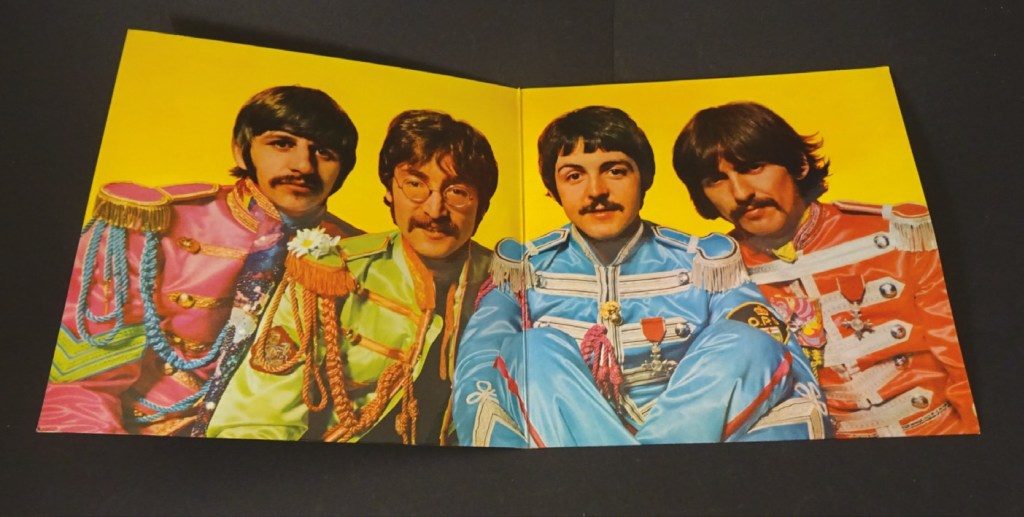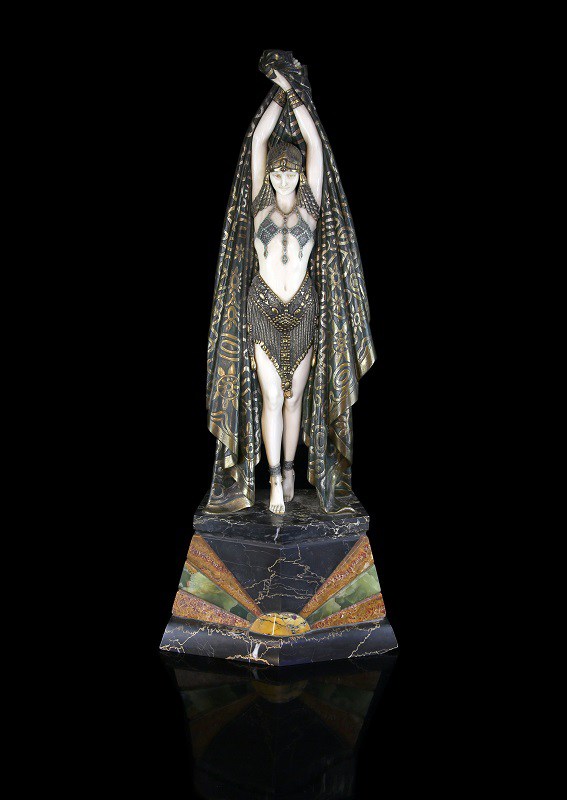Antiques Trade Talks – Izzie Balmer of Wessex Auction Rooms
 Izzie Balmer is regularly seen on the rostrum at Wessex Auction Rooms in Wiltshire. As head valuer of the busy auction house she specialises in jewellery and silver and holds two Diplomas with the Gemmological Association of Great Britain. Seen last year on BBC’s Street Auction she has also made guest appearances as the auctioneer on Bargain Hunt and Flog It!
Izzie Balmer is regularly seen on the rostrum at Wessex Auction Rooms in Wiltshire. As head valuer of the busy auction house she specialises in jewellery and silver and holds two Diplomas with the Gemmological Association of Great Britain. Seen last year on BBC’s Street Auction she has also made guest appearances as the auctioneer on Bargain Hunt and Flog It!
What areas/items are currently selling well?
There are a couple of areas… but almost anything retro, vintage or industrial. These have all been buzzwords for a number of years now but they’re still very much in fashion. Vintage signage, whether it’s original enamel signs through to 1940s and 1950s advertising posters consistently performs well.
Individual large statement pieces attract a lot of attention; rather than furnishing homes with one particular style, buyers are now looking to mix and match; it’s not uncommon to find a combination of 1960s Scandinavian, industrial and antique items all in one room. Even dark furniture is starting to make a comeback… But these pieces tend to be small, preferably Georgian and of good quality, used to make a statement in an otherwise lighter colour scheme.
What do you think are the current ‘good investment’ items – ones to watch?
 Hmmm, this is always a difficult one to answer – I wish I knew, I’d be stocking up myself! Personally, I always stick to well-made, good quality items. Makers’ marks or labels are important, handmade is always good and unusual or novelty items tend to attract a lot of attention, especially if they’re quirky and individual.
Hmmm, this is always a difficult one to answer – I wish I knew, I’d be stocking up myself! Personally, I always stick to well-made, good quality items. Makers’ marks or labels are important, handmade is always good and unusual or novelty items tend to attract a lot of attention, especially if they’re quirky and individual.
We’ve just had a very successful specialist vinyl and music memorabilia auction. If you can buy it at the right price, 1960s, 1970s and 1980s rock is a good start. It’s rapidly gaining in popularity, but if you can pick up some early pressings you’re onto a good thing.
What antiques do you have at home and why?
I currently house-share so apart from my bed and wardrobe there’s very little space in my room for much other than myself and a couple of pairs of shoes discarded across the floor. I have to stop myself from buying items because I have nowhere to store them…. No easy task when you work in a busy auction house and see beautiful objects every day! I’m really looking forward to getting on the housing ladder and being able to create my own style… I have a feeling it’ll be ‘eclectic’ because I love so many different styles and periods.
What do you think will be the antiques of the future?
 Designer furniture with a name or label on it; 1980s furniture and early IKEA furniture is starting to become popular (I know, mental!). I think anything iconic to its decade will be popular, whether that’s the 1980s, 1990s, or noughties. I also reckon nostalgic items will be popular – those items that we all remember from our childhood; items that we can relate to.
Designer furniture with a name or label on it; 1980s furniture and early IKEA furniture is starting to become popular (I know, mental!). I think anything iconic to its decade will be popular, whether that’s the 1980s, 1990s, or noughties. I also reckon nostalgic items will be popular – those items that we all remember from our childhood; items that we can relate to.
How is the industry changing and what will it look like in the future?
We do occasionally see young couples coming to the saleroom to buy items but I would like to see more.
Certainly among my friends antiques are still considered old-fashioned and un-interesting but the industry needs the input of more young people to give it a vibrancy and buzz that it currently lacks.
It’s a fantastic industry to work in, you never know what you’re going to see and each day is varied. I’m fascinated by the stories that items have to tell and I would love to see this enthusiasm in the younger generations.
You hear of a lot of auction houses’ concerns over the rise of online bidding diminishing the numbers of buyers in the saleroom and yet social media has brought an awareness of the auction industry and antiques to everyone. There are some fabulous Instagram accounts that post gorgeous photos of antiques and vintage items which get thousands of likes from people of all age groups across the world.
Online bidding encourages new buyers…. Most people have bought or sold on Ebay at some point; bidding online for a live auction is the same and less daunting for lot of auction novices.
Tell us some trade secrets – what are your top tips for buying antiques?
I would never advise anyone to buy something as an ‘investment’ item, buy it because you love it, enjoy it and if there comes a time you decide to sell it, making a profit is just a bonus. But a top tip? Condition. Make sure you’re aware of what you’re buying and any faults or repairs it may have.
What antiques/artworks would you buy if money were no object?
 It’s so difficult to only pick a couple of items! I would definitely buy a piece (or two or three) of Roman or Viking gold jewellery. I remember selling a stunning Viking gold bangle, it was such a simple design, but it was so beautiful and very wearable.
It’s so difficult to only pick a couple of items! I would definitely buy a piece (or two or three) of Roman or Viking gold jewellery. I remember selling a stunning Viking gold bangle, it was such a simple design, but it was so beautiful and very wearable.
I would also have a piece of art nouveau plique-a-jour jewellery by one of the French greats such as Rene Lalique, Georges Fouquet or Lucien Gaillard. I’d have a striking Chiparus art deco figurine and I’d love to own a Stradivarius violin.
One of my favourite paintings is JMW Turner’s The Fighting Temeraire; wouldn’t it be wonderful if the National Gallery could be persuaded to part with it …? And I think if I’m persuading the National Gallery to part with their Turner I would also persuade the National Portrait Gallery to part with their full length portrait of Queen Katherine Parr.
You’re down to your last 50 quid – what antiques/art would you buy?
I’d buy an attractive Victorian nursing chair or tub chair that has a bit of arts and crafts style to it – although perhaps not too much of an arts and crafts design because I probably wouldn’t pick it up for £50!
Where are your favourite antique hunting destinations?
Unfortunately I don’t have a huge amount of time to go antique hunting, our auctions are on Saturdays and despite my best intentions of waking up early on a Sunday to go to a car boot I’ve yet to actually do it… But I enjoy having a mooch around antique fairs and I’ll always have a quick look in a charity shop.
What are some of the biggest mistakes that buyers make?
At auction it’s getting carried away with the bidding. Whilst it’s an auctioneer’s dream to have a buyer who is determined to purchase an item at whatever the cost, it is important to decide how much you’re prepared to pay and to stick to it. That being said, it’s always worth trying one or two more bids above your limit if you really love something.
What key questions should buyers and collectors ask before buying?
It’s important buyers are aware of the condition. Don’t presume that it’s in very good condition. If possible always try and view the item. Auction houses are very happy to provide condition reports and additional images upon request.
What is the appeal of antiques in modern interiors?
It’s the contrast of an antique item within a modern interior. They draw the eye and provide a focal point. Antique items are individual; they’re statement pieces in their own right.
Why should people buy antiques over new items?
 Antiques are just much better quality than new items. They’re made to last (and have already stood the test of time) and they tend to be cheaper than the mass-produced items of today. For me they also have charm and charisma, especially the handmade pieces. They’re not perfect and that’s part of their appeal.
Antiques are just much better quality than new items. They’re made to last (and have already stood the test of time) and they tend to be cheaper than the mass-produced items of today. For me they also have charm and charisma, especially the handmade pieces. They’re not perfect and that’s part of their appeal.
Do you think young people are interested in antiques and, if so, how do they appeal to them?
This is not a straight-forward question to answer with a simple yes or no. In general I would lean towards ‘no’.
A lot of my friends are buying their first houses and are filling them with IKEA furniture. Whilst mass-produced furniture is convenient and you can purchase it immediately, none of my friends are saying to me that the IKEA items are temporary, they genuinely like the modern clean fresh look that these items offer.
I must admit I wouldn’t dream of buying an antique item for most of my friends as a house-warming present because I know they wouldn’t see the beauty that I see. However, I do see young couples coming to the auction looking for a particular item, usually furniture, for their house.
With the help of social media and the antiques programmes on TV I think antique items are beginning to appeal to more young people, especially as the prices tend to be cheaper than modern items, but I still think the industry has a long way to go to persuade the younger generations that antiques are beautiful and items to be cherished.

